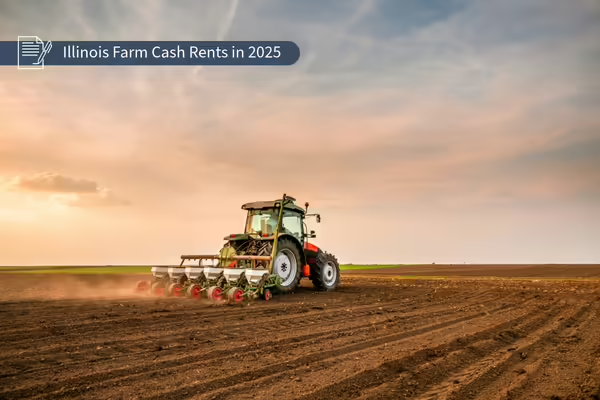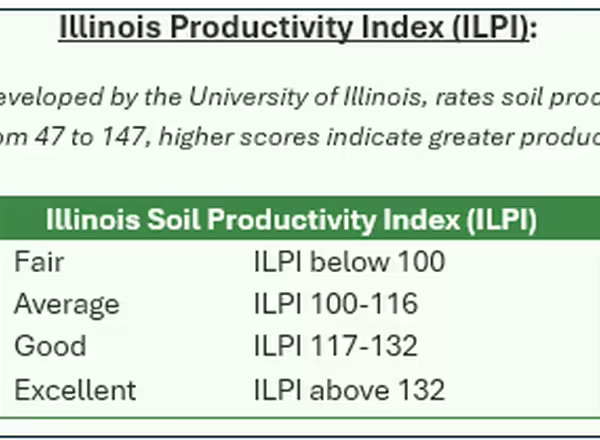
Cash Farm Rents in Illinois held steady to slightly downward in 2025 compared to 2024. At the recent Illinois Land Values Conference, farm managers from across the state released the statistics analyzed by the Illinois Society of Professional Farm Managers and Rural Appraisers (ISPFMRA). Cash rents negotiated for 2025 ranged from being flat to down 10%, depending on location. These cash rents are significantly impacted by location across the state and at the local level. Competition for leasing farmland remains strong, with Illinois having about 75% of its farmland leased.
Cash rental rates are dependent on farm profitability. Grain profits are down following higher prices earlier this decade. Ironically, cash rents are low historically compared to land values. Land values are also under negative pressure. Twenty to twenty-five years ago, cash rents typically were 4.7% of land values, whereas today, they are slightly under 3%. Most farmland is continuing to be purchased by family farms.
Farm Cash Rents are Reacting to Declining Farm Profits
Farmers and landowners are reacting to the current economic developments. Farmers cite declining grain prices, higher input costs, and higher interest rates for reducing cash rent. Landowners, in turn, are concerned about higher property taxes. Illinois property tax rates are based on previous profitability levels, and it takes six years plus to fully cycle through higher profit years to see lower property taxes.
Soil Quality Impacts Cash Rent Changes
Rents on Illinois farms declined slightly more often on excellent soils vs. fair to good soils. However, some locations still report cash rents of $450 to $500 per acre on excellent, well-drained soils with solid fertility levels. Recently negotiated leases on excellent farmland ranged from below $350 to $450 per acre level in some places.
Good soils also had a variable cash rent level ranging from $300 to $400 per acre. Some locations experienced intense competition in offers for cash rent in the good range, provided there is good drainage. Good soils can yield competitively compared to excellent soils, where drainage is in good condition and soil compaction is limited.
In farmland with soils rated average, the cash rent declines were generally more modest, with some areas seeing a modest increase. Average soils ranged from $300 on some leases in the Interstate 70 corridor east of St. Louis to below $200 to the south. Cash rents for fair soils were variable, being steady to slightly down.
Farm producers vary in their ability and willingness to pay higher cash rent. Relationships are a significant factor in the landowner/farmer cash leases. Landowners can contact their local NRCS office for help in determining the PI of their farm on the Bulletin 811 Index. (http://soilproductivity.nres.illinois.edu/Bulletin811ALL.pdf)
Most Farm Leases are Cash Rent
Statewide, cash rents represent 77% of professionally managed lease arrangements. Cash rent is divided, with 41% of the leases being traditional cash rent and 26% being flexible cash rent, usually depending on yields and grain prices. Five percent of professionally managed Illinois farmland is custom farmed: the landowner hires a farmer who is paid a fee for the farming services. An additional 28% of lease agreements between farmers and landowners are crop-share arrangements: the owner and farmer share certain costs of operation and then profits.
The 2025 crop growing season, and the resulting yields will determine farmer profits and whether the downward pressure on cash rents persists in 2026. Farmers and landowners should closely monitor the economic situation throughout 2025. Written lease terms typically dictate the renewal of the lease arrangement for the following year. Parties to a farm lease contract should be in communication as the fall approaches about cash rent levels for 2026.
Farmers and landowners can download for free the full 2025 Farmland Values and Lease Report here: https://ispfmra.org/2025/03/27/download-now-our-2025-land-values-lease-trends-report/

University of Illinois Extension develops educational programs, extends knowledge, and builds partnerships to support people, communities, and their environments as part of the state's land-grant institution. Extension serves as the leading public outreach effort for University of Illinois Urbana-Champaign and the College of Agricultural, Consumer and Environmental Sciences in all 102 Illinois counties through a network of 27 multi-county units and over 700 staff statewide. Extension’s mission is responsive to eight strategic priorities — community, economy, environment, food and agriculture, health, partnerships, technology and discovery, and workforce excellence — that are served through six program areas — 4-H youth development, agriculture and agribusiness, community and economic development, family and consumer science, integrated health disparities, and natural resources, environment, and energy.